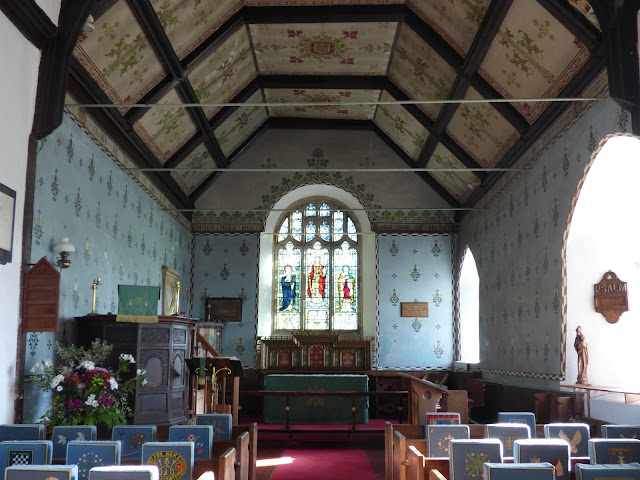As this little church was only a mile from the smallholding I really should have been inside it before, but I hadn't. So it was all a nice surprise.
The tower was completely rebuilt in 1900 but it is thought to be a copy of the original from the C14.
The reason for Friston church getting a mention in the 100 treasures book is because of this. The enormous Royal Arms of King James I (1603-25) which dominate the church. It's over 6 feet square and carved from planks five inches thick.
Royal Arms began to be displayed in the reign of Henry VIII, were banned by Queen Mary and during Cromwell's time but in 1660 Charles II made it obligatory. The pieces of this wood carving were found abandoned in the tower in 1935 and reassembled.
This is the cover of what was probably the church's first English Bible from about 1550. I tried to get a photo without reflections but it was impossible.
The organ is up a twisting flight of stairs - a real Organ Loft.
As we say in Suffolk, my photography is "Slightly on the huh!".............sorry.
One half of the church has a beautiful painted and stencilled ceiling and walls which have survived since Victorian times.
Many of the churches I've been to have had lovely tapestry kneelers, as these were all stood up I remembered to take a closer picture.
Some good stained glass over the altar,
This window has a much more recent coat of arms for one of the Vernon-Wentworth family who once owned all the land around Friston and hundreds of acres right down to the coast at Aldeburgh, When we had the deeds for the smallholding we found they had once owned the land way back in the early 1900's before it was sold off to a small farmer and then sold again in 1955 - when the bungalow was built.
An 1811 notice about the bequeathing of money for the poor, there's more about this on the Suffolk Churches Website
I'm pondering on Poor Housekeepers................. as I don't like dusting .........would I have qualified!!
The base of the C19 font is probably the original font bowl turned upside down, something that seems to have happened in many churches.
I'm glad I took part in lots of quizzes in the adjacent village hall which were held every year to raise funds for looking after this little gem of a church.
Back Tomorrow
Sue










It's a delightful church and those kneelers represent weeks of time-giving dedication.
ReplyDeleteI wonder why they turned the original font bowl upside down instead of continuing to use it. Intriguing.
xx
Turning the old font upside down to use as a base for the new has been mentioned in lots of the churches, maybe the old fonts were damaged or perhaps someone bequeathed money for a new font. I thought perhaps it was because they wanted something with more carvings, but that can't be the reason here because it's one of the plainest I've seen.
DeleteI suppose the reason is simple, reuse and recycle. When you look at the fabric of a church, even if it has been remodelled time and again, is the fact that carved stone from wayback such as the Saxon or Norman era are reused. Love the Victorian decoration of the roof.
DeleteWhat a lovely cared-for little church. The quality of the tapestry on those kneelers shouts out that it has a community who back it still. (Loved the grey horse one!)
ReplyDeleteHow fascinating it is - especially that huge coat of arms. I should imagine many fell foul of woodworm in the past (or ended up as firewood). Isn't is odd, we rarely go to the really local places around our home!
Although we were only a mile away we were in a different village so I'd been to lots of things at Knodishall church especially when Youngest was at primary school but somehow never been in Friston church
DeleteAs Bovey Belle said it is a little lovely little church. The kneelers are beautiful. I stitched "For Home and Country" to the church that use to so to. I learn so much from you Sue.
ReplyDeleteHazel c uk
It seemed very welcoming - I felt guilty that I'd never visited it before when we were so close
DeleteGorgeous Victorian ceiling and walls - I've never seen such a thing before
ReplyDeleteA lot of stencilling and painting in lovely colours that have survived so well
DeleteAn amazing amount of intriguing detail in the church. From your photos it gives the appearance of a well-loved, even happy, place.
ReplyDeleteVery well cared for by the village church-goers
DeleteA lovely church. Here in Texas, we have a number of what we call "painted churches" where the walls and ceiling are stenciled and painted. Some of them are very colorful and ornate. Your photos are great-thanks for this post!
ReplyDeleteWow, such beauty, the stained glass and those ceiling were a delight. I can only imagine the work that went in to those kneelers what a joy.
ReplyDeleteIt's very easy to miss the kneelers, but some of them are real little gems. Arilx
ReplyDeleteGorgeous ceiling and walls. The kneelers are beautiful.
ReplyDeleteGod bless.
What a beautiful church! Thank you for sharing all these lovely old churches. And I don't mind the not perfect photos at all - I'm guilty of that kind of photography too.
ReplyDeleteI'm right behind you in the lineup of poor housekeepers - I don't like to dust either. Ha ha!